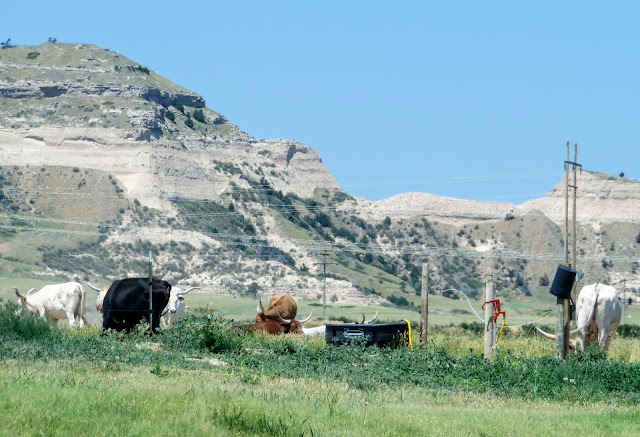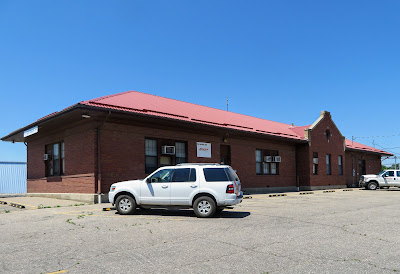…continuing with our July 2021 road trip and exploration of northern and western Nebraska.
Along the way, we passed yet another deserted one-room school house that is slowly falling apart. The only difference between this school and the one I noted in the previous post is that this one lacks a chimney.
If you look closely or, better yet, if you enlarge this photo, you will see that it shows hundreds of cattle in a feedlot. For a couple of days in a row, we noted many such operations along our route. I believe that this farm/ranch feedlot is part of Minatare Feedlot Inc. The largest feedlot in Nebraska is the Adams Feedlot near Broken Arrow. It processes an estimated 270,000 head of cattle every year. Nebraska has the second largest number of cattle on feed in the USA, behind only Texas. That number approaches 3,000,000 head…
Did I mention that it was 61 miles between Hemingford Nebraska and the City of Scottsbluff! Scotts Bluff National Monument is actually located just west of the town of Gering Nebraska.
Scotts
Bluff National Monument protects 3,005 acres of mixed-grass prairie, overland
trail remnants, rugged badlands and striking bluffs as well as a riparian area
along the North Platte River. In 2019,
the National Monument attracted over 190,000 visitors.
The monument’s north bluff…as shown in the first photo…was named after Hiram Scott. He was serving as a clerk for the Rocky Mountain Fur Company when he died near the bluff in 1828. Scott was also a mountain man, trapper and pelt trader. He was only 23 years of age when he died. His cause of death has been debated and speculated on over the years. Illness, Blackfoot Indians or foul play by members of his party have all been claimed. In any case, not only have the bluff and the National Monument been named after Hiram, so has the city and the county in which the monument is located.
The Department of the Interior designated Scotts Bluff and several nearby bluffs as a National Monument in December of 1919. This is the headquarters and visitor’s center for Scotts Bluff National Monument. This is actually referred to as the Oregon Trail Museum and Visitor Center. Among other uses, it serves as the start for hiking tours of the bluffs. Exhibits focus on westward expansion and pioneers.
Visitors can see for miles in every direction from the top of Scotts Bluff. It served as an important landmark along the Oregon Trail as well as for the California and Pony Express Trails. It could also be seen from the nearby Mormon Trail. Between 1843 and 1869, over 250,000 westbound emigrants passed by Scotts Bluff. As noted in pioneer journals and diaries, this bluff was a truly significant landmark along their route.
As you
can see from this last photo of the bluff and the surrounding area, there is a
roadway to the top of Scotts Bluff. It
was built during the Great Depression by the Civilian Conservation Corps (CCC)
under Franklin D. Roosevelt’s Administration.
The road passes through 3 tunnels along the way…
Not far from Scotts Bluff, we took this photo of a small group of Texas Longhorn Cattle. This breed of cattle is known for its huge horns, which can extend to over 100 inches (8 feet +) from tip to tip. Both cows and bulls sport these big horns. They are descendants of the first cattle brought to the Americas, first by Christopher Columbus and later by Spanish colonists.
Although
numbers of Texas Longhorn Cattle declined to the point where the breed was
endangered, they have rebounded in recent years. In 1964, it was estimated that there were
only about 1,500 pure bred Texas Longhorn Cattle remaining. Today, they number over 330,000. In 1865, Longhorn cattle were estimated to
number up to 4,000,000 head. These cattle are relatively docile, they don’t
require all the care that other beef cattle require and they have a high
drought-stress tolerance.
FYI…In
1995 the Texas Longhorn was designated as that state’s large mammal. The best of the breed can be pricy…with a
record price of $380,000 for a cow, 3S Danica, and a heifer calf at her side.
This is the old Union Pacific Railway Depot in Gering Nebraska. The second photo shows the depot being relocated ca 1913 after a long political battle over land. It was the first of at least 2 moves for this depot. Today, it appears to be well maintained but unoccupied. It was replaced by a new depot in 1928.
We also found another railway depot in Scottsbluff. This is the ca. 1920’s former Burlington Railway Depot. It’s now being used as Maintenance of Way (MoW) site or office for the Burlington Northern Santa Fe Corporation’s rail system.
Maintenance
of way operations are assigned the responsibility of ensuring that the railway
remains clear and safe. Tracks have to
be regularly checked for damage to rails, missing or damaged ties and a
multitude of obstructions. I can’t
imagine how rough this job would be in the middle of the winter across the
great plains of America…
The former Lincoln Hotel in Scottsbluff Nebraska is listed on the National Register of Historic Places. It was completed in 1918 for the Nebraska Hotel Company. The structure, located near the Scottsbluff railway depot, was designed in the commercial Classical Revival style. This 6-story building is the tallest in Scottsbluff.
As of
1964, this building ceased to be a hotel.
Off and on it served as a college dormitory for 2 different
colleges. Today it’s called the Lincoln
House Apartments. With its 35 1-bedroom
and 20 2-bedroom units, it provides low cost and senior housing. I always appreciate repurposing, especially
if the character of the original building is preserved.
It may not look the part, with its tattoo parlor on one end and an empty storefront on the other, but the Marquis Opera House is another Scottsbluff location listed on the National Register of Historic Places. It was built in 1910 as a theatre with an auditorium inside. The first floor was retail sales space and the second was the town’s first ‘opera’/performance venue.
This venture was not successful and it closed down in 1912. In 1916, the building was redesigned in the Classical Revival style. The auditorium was turned into floors for apartments and offices and a third floor was added. Problems continued and the building changed hands again. For a time, the main level housed a restaurant, a bank, barbershop and retail space. The second floor was used as office space and apartments while the third floor was mostly vacant. Looks like the struggle for profitability continues…
The final photo from our short tour of Scottsbluff is of the Midwest Theater at 1707 Broadway. This theater was designed in the Moderne style and it is considered a fine example of this style of architecture as found in 1940’s motion picture design. It was completed in 1946. The first movie shown here was “Gilda”, staring Rita Hayworth and Glenn Ford. Check out this classic movie’s preview at https://en.wikipedia.org/wiki/Gilda.
This
theater was built on the site of the Egyptian Theater, which had been destroyed
by fire. This new ‘grand theater’ was
described as having “a tower entrance that is 68 feet high, containing stars of
pressed aluminum and topped with flashing aluminum-encased bulbs which give a
‘diamond illumination’ effect at night”.
It also featured a large screen, blue leather and rose ‘push back’
seats, wide aisles and both air conditioning and sound systems specifically
designed for this building.
The first
owner of the theater closed it in September of 1996. The building and fixtures were donated to the
Oregon Trail Community Foundation for use as a community performing arts and
entertainment center. Today the theater
provides both live entertainment and recent cinematic offerings. The movie “No Time to Die” was showing when I
took the photo. To see what’s up now,
just go to https://midwesttheater.com/.
From
Scottsbluff, we turned back toward Omaha through part of the central portion of
Nebraska…
Just
click on any of the photos to enlarge them…
Thanks
for stopping by for a visit!
Take
Care, Big Daddy Dave


















You and Laurie were having a busy summer, haven't you?
ReplyDeleteIt's sadly that school looks so abandoned.
I don't think you can go much further west in NE. I'm really surprised that that are second in cattle - I would have thought WY or MT.
ReplyDelete